Student Blog

Meaningful Occupations in the Reinberg-Rivera-Ritter Household ⟩
November 12, 2020, by Liz
As OT students it’s so easy to get caught up with work, class assignments, and other responsibilities. It’s so easy that we forget how important it is to take care of ourselves and take some time to engage in meaningful occupations! This year I have had the pleasure of living with two of my best friends, Lorelei and Renee. Over the course of being in this program, we’ve really gotten to know each other. I don’t know what I would do without them! I thought it would be cool to share some pictures of some of the meaningful occupations we’ve been engaging in to relieve some stress and spend some time together as a family.
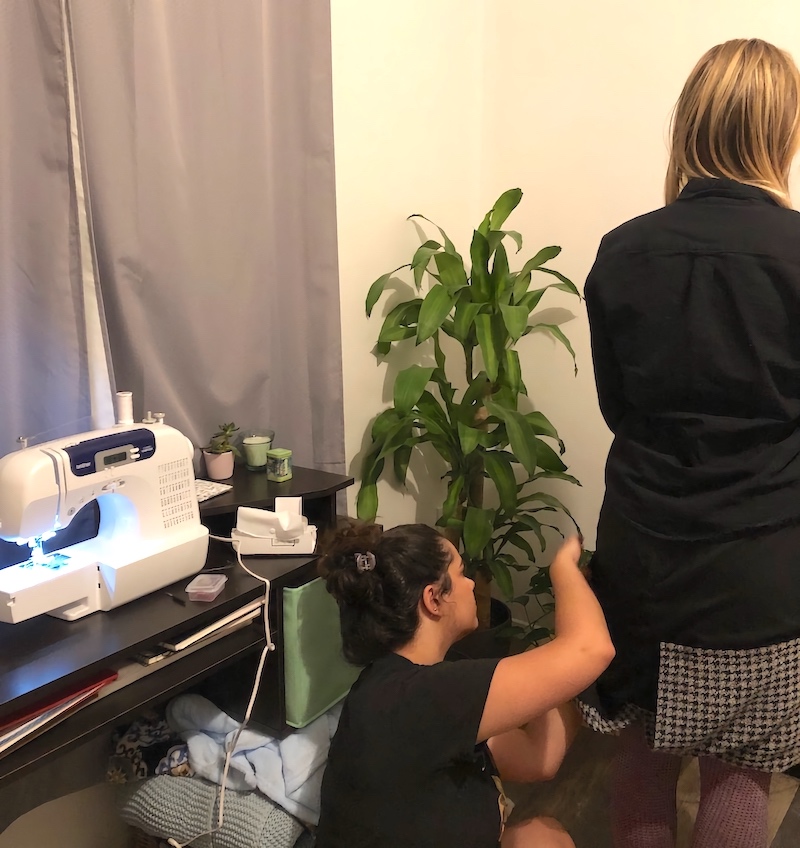
Renee just recently got a sewing machine, and so of course Lorelei put her to work! Here she is attempting to professionally hem Lorelei’s skirt. So yes, we now have our very own seamstress in the house! The only downside is that her work may take more than 10 business days to complete.
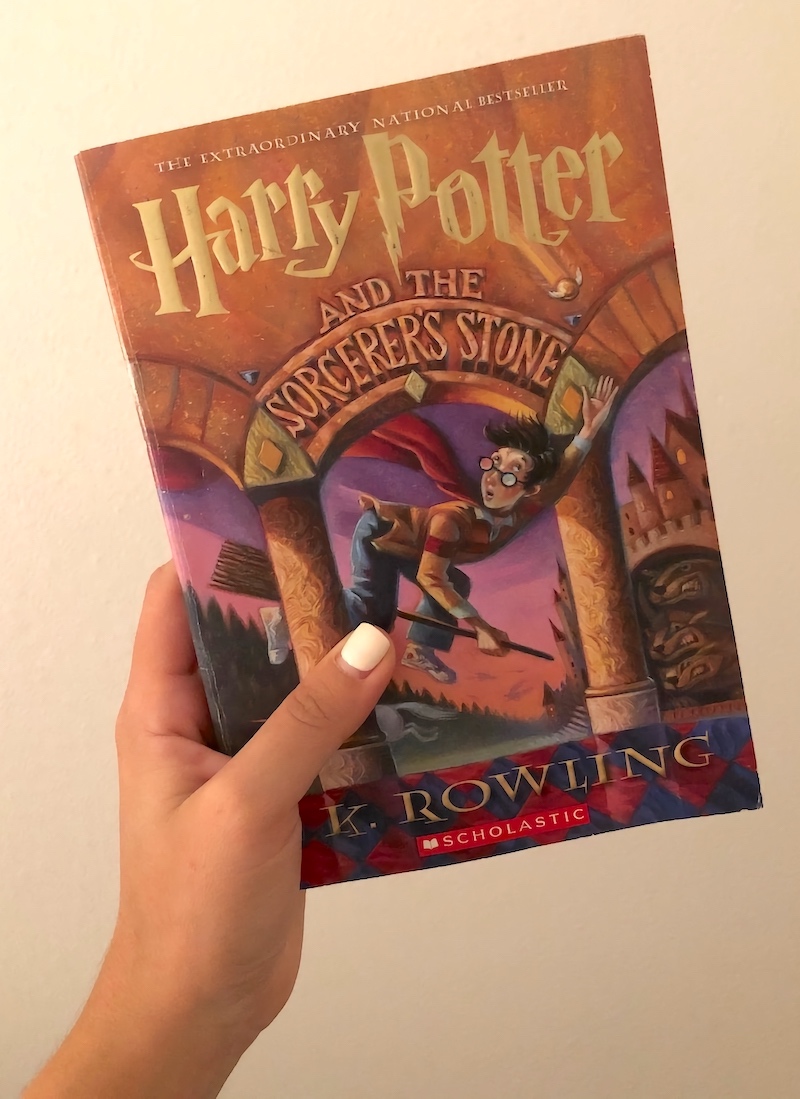
As a kid, I used to love playing outside with my friends. Whenever I think about my childhood I think about running around the apartment complex and racing around in scooters with my friends. My elementary school used to have a thing called AR (not sure if that is still a thing), in which we would have to accumulate a certain number of points by reading books. I really did not like reading books as a kid because I loved being outside playing with my neighbors. As I got older reading became more enjoyable of course. So, now I have decided to read the entire Harry Potter series, which I never read as a kid!
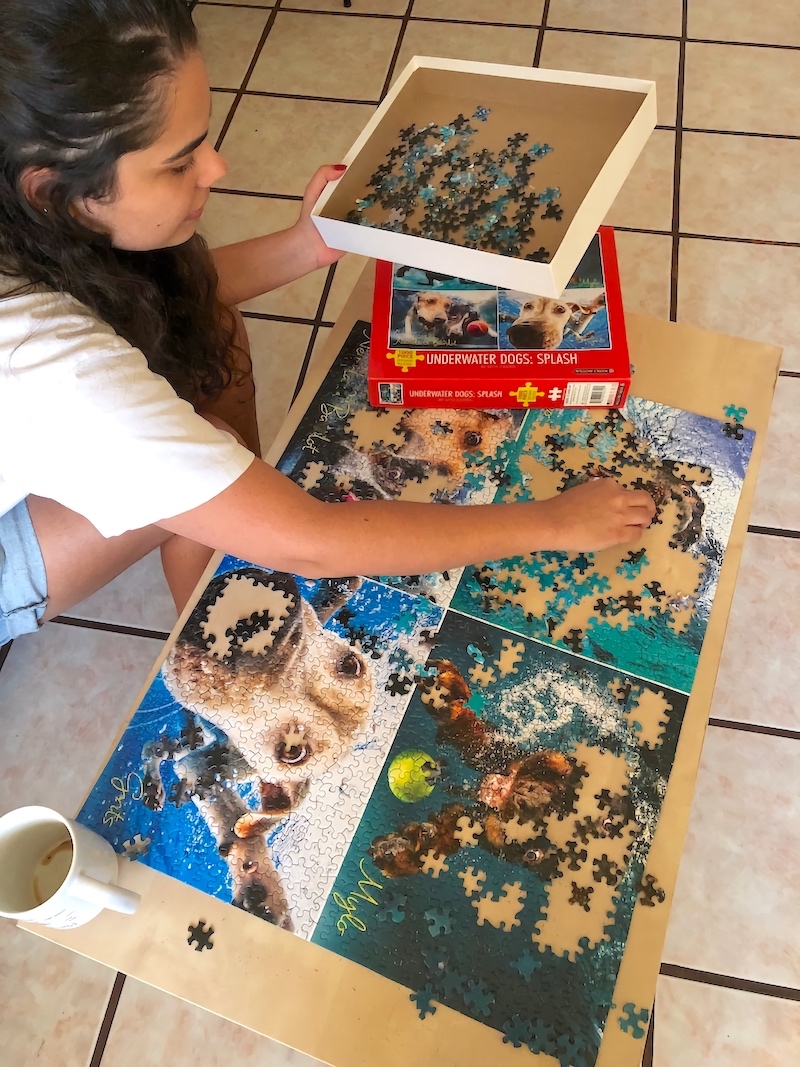
Here’s Renee taking a little study break. We started working on a 1,000 piece puzzle as a household, but I have to admit most of the work was done by Lorelei and Renee. There are way too many shades of blue, green, and white in there. I did cheer them on from the couch, though!
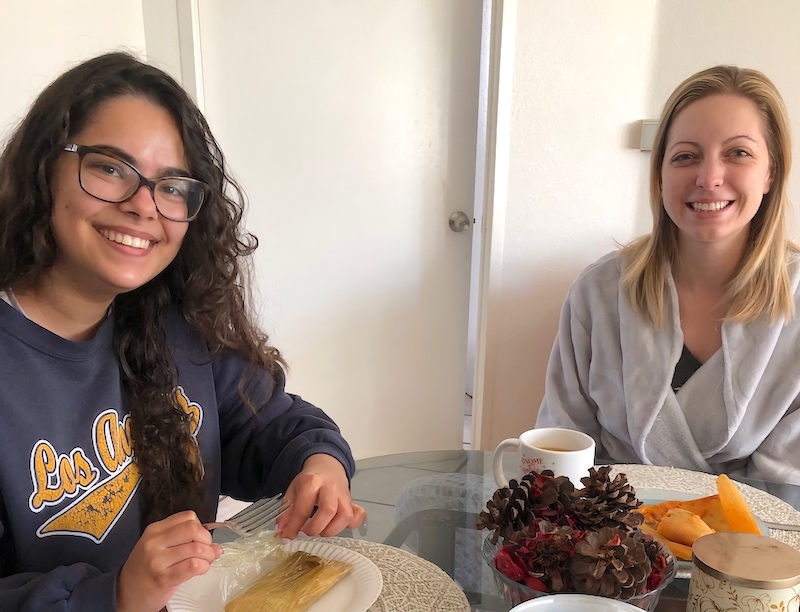
One of the most beautiful parts of living in East Los Angeles — delicious food everywhere! I woke up early before class to buy us some tamales so we could enjoy a little breakfast. Yum!
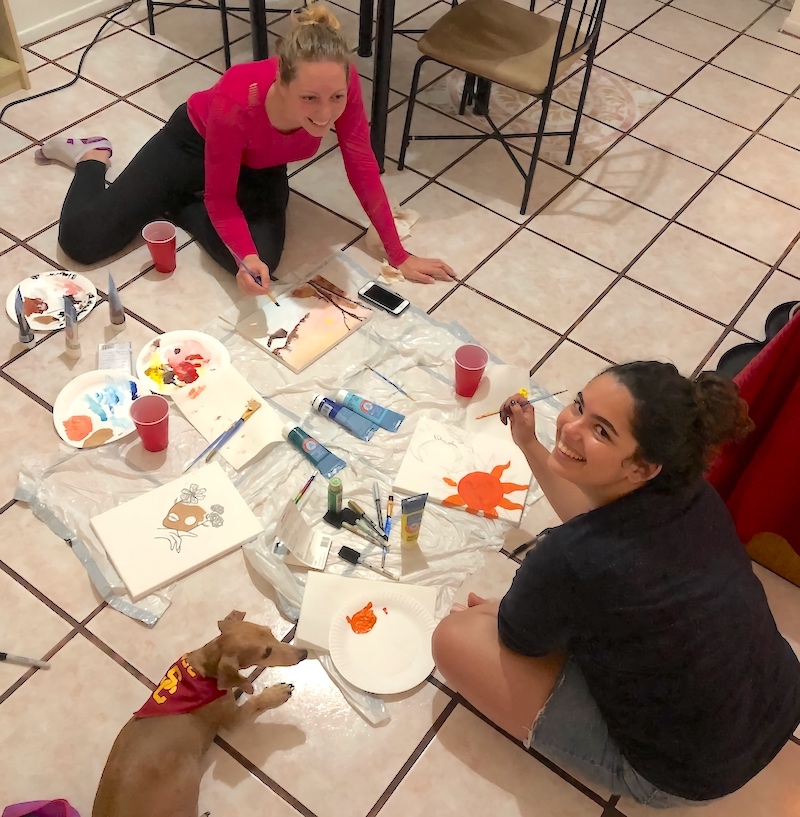
And lastly, here we are enjoying a little paint night! Lorelei was painting something for her mom, I was painting a gift for my little sister’s birthday, and Renee was painting something for her room. We were playing holiday music because both Renee and Lorelei will be going back to the east coast for the holidays. And Maxy is supervising of course.
These pictures bring me so much joy! I am so lucky to have the best roomies in the world. As an OT student in our program you can expect to receive a great education and learn from some of the best OTs out there. But, you can also expect to develop beautiful friendships with some amazing people!
⋯
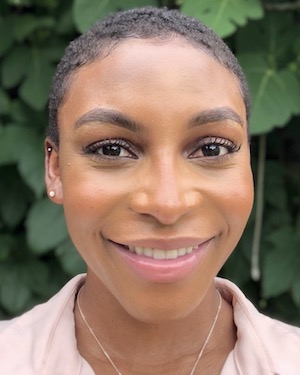
Being “First-Gen” ⟩
November 9, 2020, by Lamoni
Admissions Diversity First-Gen
This week is USC’s “First Generation Student Week.” USC defines a first-generation student as someone whose parents do not have four-year college degrees. At USC, roughly 20% of the students are considered “first-gen” and that includes me! Because this week is about highlighting first-generation students, I want to talk about what this experience (being the first person in my household to go to college) has been like for me. If I were to sum it up in a few words, I would say “challenging but rewarding.” I know how cliché and overused that phrase is, but it is true.
My mother was still in high school when she had me and though her and my dad regularly tell me how much joy I brought to their lives, they acknowledge the multiple challenges that come with being a young parent — one being completing higher education. Since I could remember, education, getting good grades, and going to college has been ingrained in my upbringing. After school, when my friends would play outside, I had to read “hooked on phonics” books first. Honestly, growing up in New Orleans with debilitating humidity, I was happy to stay indoors to read. My parents pushed education because they wanted me to have experiences that they did not. They instilled a hunger for learning because they figured it would keep me on the “right track.”
All my life, I strived for As. It started with getting incentives by the end of the week (a stop at Toys R’ US or extra money in my allowance) but then it was more long term — I wanted to get into a “good college” and make my family proud.
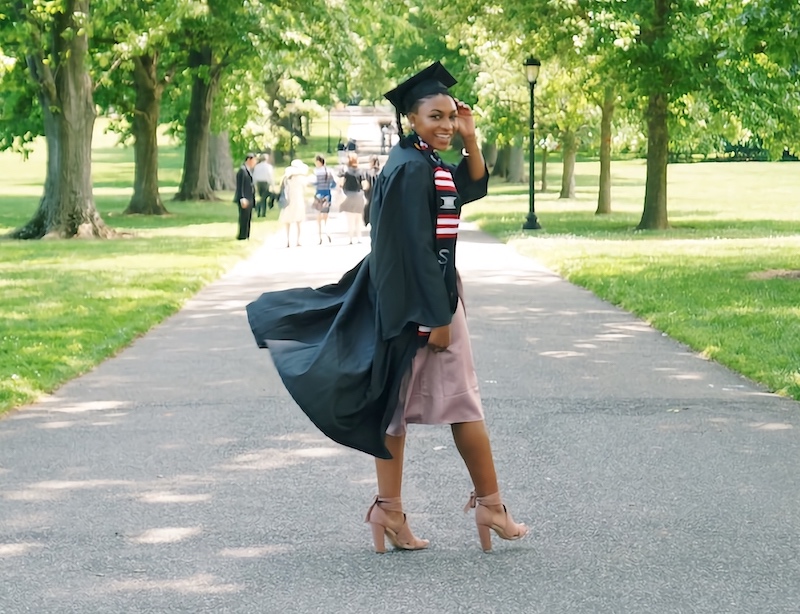
Photo of me in my cap and gown after graduating from college
Before college, everything felt like a straight path. School had always been “easy.” I never had to think about financing my education or having a place to live alongside completing readings, meeting deadlines, studying for tests. What was expected of me had completely shifted. On top of that, I went to school out of state and had absolutely no family around me. I remember a couple of times when I would cry on the phone to my mom because I felt overwhelmed. The most difficult part was reaching out to my parents and them not being able to help me. As a child and sometimes as a teenager, your parents are your superheroes. In the past, I could reach out to them for anything and together, we could come up with a solution. But now, I had to figure out everything on my own. From difficulties in class, to being a student worker all the way to handling east coast winters. They had no answers. For the first time in life, I could only rely on myself. As someone that takes a while to open up to people and someone that does not like asking for help, there were moments when I truly struggled.
During those moments of confusion and exhaustion, what kept me determined was my family — specifically, my siblings. I did not know what I was doing but I was going to figure it out — for them. Because, then, they would know that it was possible. Though I always had what I needed (food, water, shelter), I was raised in a low socioeconomic class. I, and the rest of my neighborhood, grew up on food stamps. Though my parents sheltered me as much as they could, I saw a lot of violence growing up, I saw substance abuse, and I saw family members taken away to jail. I saw what happens when people are not exposed to better opportunities or lack proper support to obtain those opportunities. I did not want my loved ones to be in that position. My parents could talk about how college was the right route to go, but they could not show me. I could show my brothers and sister and I could make my parents proud along the way. This was an opportunity to pave the way.
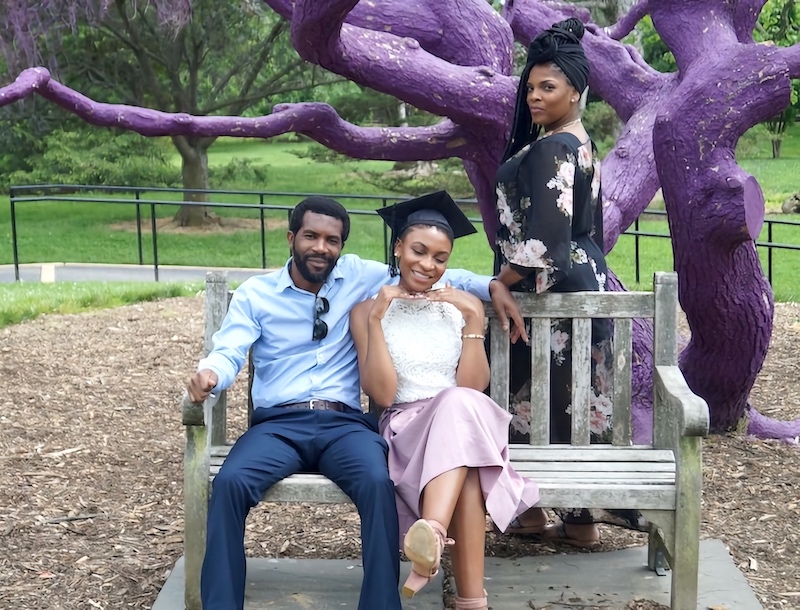
Picture of me and my parents after my college graduation
Because I am the first to get my bachelor’s degree, I will also be the first to get my master’s and later, the first to get my doctorate. While I am immensely proud of myself, I am not the only person that I do it for. As mentioned, I do it for my family. But, I also do it for other first-generation students. It is very difficult to go through such an extreme transition without guidance from your guardians. People discuss college as something that everyone must do — like it is some sort of “no-brainer” but they do not talk about how hard it is, and the resources to get through it is not readily available.
I love that there is a First-Generation Student Week because it acknowledges the challenges that first-gen students experience, congratulates us on our triumphs and provides resources so that we can continue moving forward. To all of the first-generation students, I am so proud of you. You have accomplished so much and you will continue to accomplish so much more.
⋯
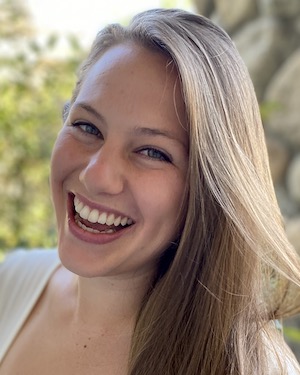
Will I Have Time to Work During the Master’s Program? ⟩
November 4, 2020, by Savi
As the Nov. 1 application deadline has just passed, I have been receiving many questions from prospective students about balancing a job and graduate school. Although this experience will vary from person to person, I thought it could be helpful to give you all a bit of insight into my experience balancing work and graduate school!
The Entry-Level Professional Master’s program begins with a jampacked 8-week summer semester in which you complete foundation-based courses like Kinesiology and Neuroscience in an extremely short amount of time. This makes for a high intensity and fast-paced semester with class from Monday-Friday 8:00am-4:00pm and a few hours studying upon your return home each afternoon. I, therefore, chose not to work during the first summer. I had also just completed my undergraduate degree a week before beginning the Master’s program and hadn’t even found a place in LA to live yet! I was grateful to have a few hours on the weekend or on Friday evenings to apartment search, find a job for the fall semester in my new neighborhood, and get to know the fun city I was living in.
During my Fall semester in the Mental Health Immersion, I felt like a weight had been lifted from my shoulders. I was in class three days a week, completing my Fieldwork I one day a week, and had my Friday’s completely free! This allowed me more time to take on a part-time job as a gym receptionist and sales associate at a gym near my apartment. They allowed me to work extremely flexible hours, as they understood I was not available during most of the week. I worked the evening shift after school one night a week, the Friday afternoon shift, and a weekend shift, which all combined to approximately 20 hours a week of work on top of graduate school. Was this easy? No . . . it was really overwhelming at times and I did not have much time to participate in social or revitalizing occupations (such as sleeping a sufficient amount of hours every night!). I am very thankful that I was able to fit in some studying or homework during my work hours if we were having a slow day, that I loved spending time with my co-workers, and that I was allowed to take a free workout class during each shift. If this wasn’t the case, I do not think I would be able to commit 20+ hours a week to a job while completing my Master’s degree (also I wouldn’t recommend it regardless because it was TOUGH). I continued this workload during the following Spring Semester in the Pediatrics Immersion. It was nice to make some money and work on applicable skillsets for the OT field, such as adjusting your communication style depending on the customer, giving clear and concise directions, or staying organized and calm during chaotic or unforeseen situations.
At the end of my Spring semester, I was exhausted and I needed a change. I knew the Adult Rehabilitation Immersion was coming next and as a student interested in working in an inpatient hospital setting with adults in the future, I wanted to have more time to focus on all the valuable coursework. The Student Ambassador position became available and as a previous college tour guide, I was thrilled by the opportunity to step into a similar role for a program I love dearly. After applying and interviewing, I was lucky enough to be chosen as one of the Student Ambassadors and was extremely thankful for the expectation that we were to work 10 hrs/week. On top of that, working for the Chan Division allows you a lot more flexibility with your hours, as the faculty you are working for understand the workload you are trying to balance. Thank you to Kimberly Kho, our AMAZING supervisor/boss, for being so flexible, understanding, and respectful of our busy and ever-changing graduate school schedules. Kim has always reinforced that academics takes priority and has allowed us to adjust our schedules to provide more time on particular weeks to study for exams, write big papers, etc. Visit Yna’s blog to learn more about what we do as student ambassadors!
From my experiences, you may have noticed a trend. Can you work in grad school . . . yes! It is doable depending on what job it is and how much flexibility it allows you. I am grateful to have had understanding bosses and incredible, fun, and kind co-workers in both of my jobs! Be sure to weigh the pros and cons of the job before you commit to it and make sure that you are prioritizing your physical and mental health! As Kim says . . . you are a student first.
⋯
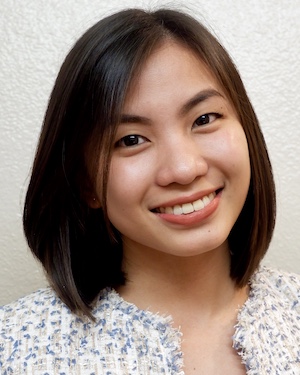
Life as a Student Worker ⟩
November 2, 2020, by Yna
Classes Getting Involved Videos
“Is it possible to work while studying?” This is one question that frequently comes up and understandably so, given the full-time enrollment and the intensive nature of the academic programs at USC Chan. The answer to this question is yes, it is a possibility for one to work while studying. Although it really depends a lot on the individual, I would say roughly about 10-12 hours per week is recommended. To give you a better idea on how this is dispersed throughout the week, I am going to share with you my typical work-study schedule and some of my duties as a student ambassador.
As a Post-Professional Master’s student, I am currently taking a total of 18 units for this fall semester, comprised of 3 core courses (8 units) and 3 elective courses (10 units). For a better visualization, here’s a table showing how my weekly class schedule looks like.
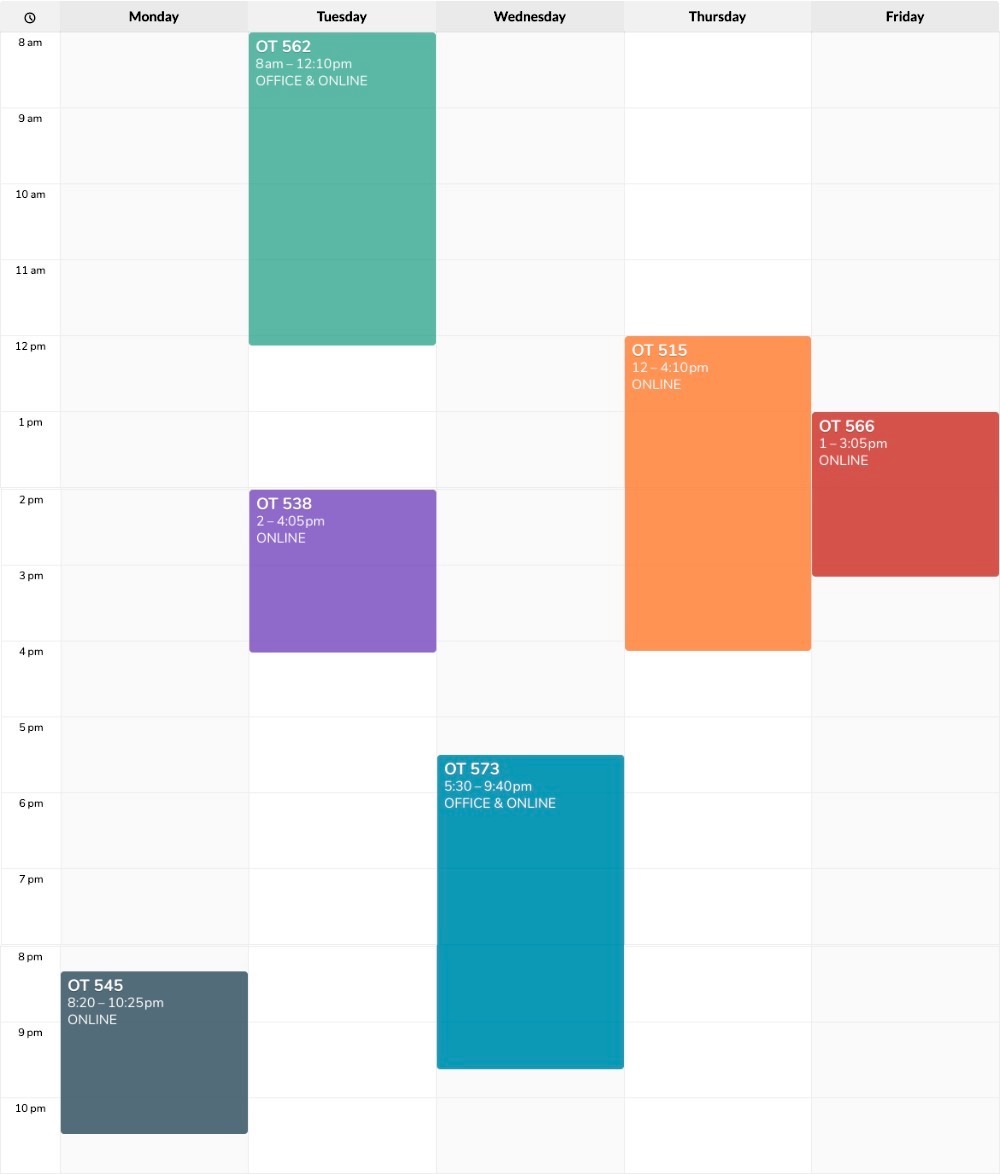
Class schedule for the fall semester
As you can see, you really only spend a few hours of your day sitting in class. However, do note that for each course, there are out-of-class activities and requirements that need to be worked on, which could take up a substantial portion of your time.
I schedule my work hours as a student ambassador around my class schedule, so I typically work on Mondays, Wednesdays, and Fridays in the morning before my class, totaling to 10 hours per week. One thing that I really like about being a student worker at USC Chan is the flexibility in scheduling that they give students that allow us to move our time around in case we have exams or other requirements to prepare for. This is also made possible by the amazing team of student ambassadors who are always willing to help out whenever one of us is having trouble fulfilling our duties. Our supervisor, Kim, never fails to remind us on every team meeting to prioritize our academics and also take care of our health.
One of my tasks as a student ambassador is to liaise with Global Initiatives for certain projects. This is another area where I find the flexibility in scheduling really helpful, especially for time-sensitive projects, because you can choose to dedicate most of your work time to accomplishing it or even work on the weekend if you’re willing to. For example, for the recent World OT Day last October 27, we created a video that shows how people all over the world have reimagined their doings. Check it out below!
Sometimes, I also give informational presentations together with the admissions team, as part of our role to help raise awareness about occupational therapy and our programs at USC. Other ways we can disseminate information and share our experiences as current students and student workers is by posting to Chan Division social media accounts (check us out on Facebook, Instagram, and YouTube!), writing blog posts about our experiences, and answering questions from prospective students. Lastly, student ambassadors also partake in certain steps of the admissions process, with the guidance of our Director of Admissions, Dr. Anvarizadeh.
Hopefully this glance into my life as a student ambassador answers some questions you may have about being a student worker! If you have any questions, you can reach the ambassadors at .(JavaScript must be enabled to view this email address).
⋯

A HANDful of Fun in Hands Electives ⟩
October 29, 2020, by Liz
The end of the semester is approaching, which means it’ll soon be time to wave goodbye to the best electives ever! Okay, yes I am biased because I really do love hands and hand therapy. I was initially pretty bummed about having to complete these electives via Zoom because I was nervous about not being able to do a lot of hands on work. No pun intended! But, I am happy to say I was proven wrong. I’ve had a blast learning in both OT 573: Hand Rehabilitation and OT 562: Advanced Hand Rehabilitation and Certification (PAMs).
Lisa Deshaies is the instructor for OT 573, and I have learned so much. We’ve learned about the anatomy of the hand, which I have to admit was really intimidating to think about at first! Lisa does a wonderful job of going over the anatomy of the hand and has some wonderful tips on how to remember different parts. In her class we’ve also learned about several different diagnoses, such as osteoarthritis, arthritis, and carpal tunnel syndrome to name a few. We’ve discussed the importance of wound care and the different phases of healing. We’ve talked about different orthoses and have had the opportunity to critically think about which orthosis we would recommend given different client cases. Lisa has shared so many resources with us to continue practicing our knowledge of anatomy and is so patient when explaining different concepts in class. This week we had our first in-person course, where we practiced casting. It was so much fun! I had seen this done at the hand therapy clinic I worked at, and I finally got to try it. Here’s some pictures!
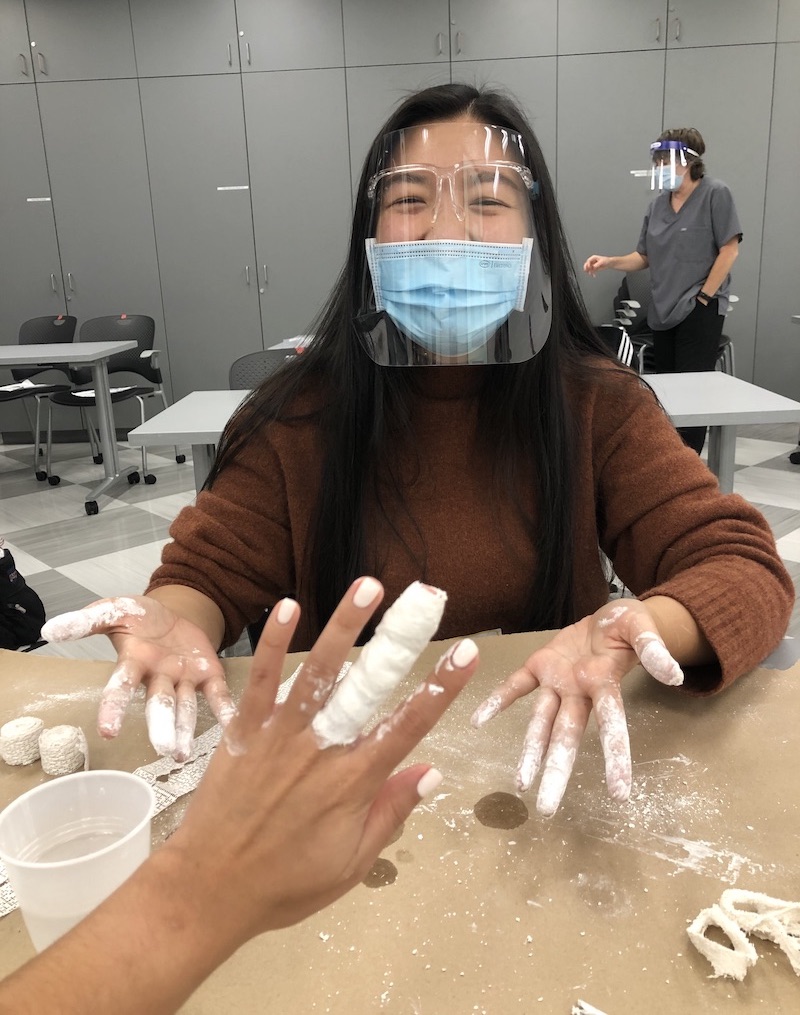
My partner and MA II student, Bethany, made a pretty awesome cast on my finger!
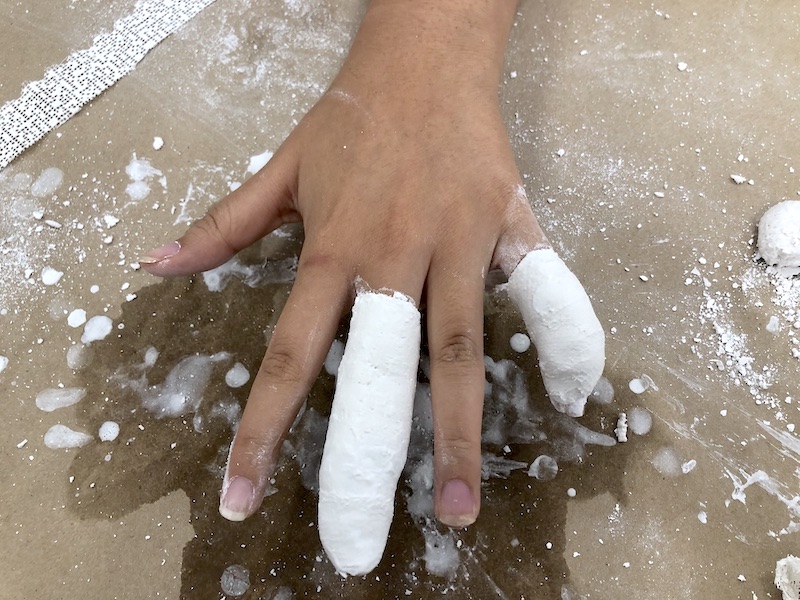
My attempt at casting Bethany’s fingers. It was fun to get a little messy and practice!
In OT 562 we’ve learned about a multitude of physical agent modalities that may be used in hand therapy practice. We’ve learned about ice/ice massage, hot packs, ultrasound, transcutaneous electrical nerve stimulation (TENS), neuromuscular electrical stimulation (NMES), paraffin, iontophoresis, and phonophoresis. Aside from learning about the modalities from our instructor, we’ve had a chance to learn from each other. Each student has had a chance to become familiar with one of the modalities I listed and presented during our small groups. We’ve learned about the precautions and contraindications, parameters, and when/why we would use the modality with clients. Dr. Rocker is extremely knowledgeable and has challenged us with multiple case studies that allow for us to critically think about which modality, if any, we would use in different cases. Some of the cases presented in class are cases that Dr. Rocker has seen in practice, which is really cool! We’ve had class on campus to try out ultrasound (sorry, I forgot to take some pictures!). We also had TENS/NMES units mailed to us from the Division, which we’ve had a chance to try out during class. It was a really cool experience to know what the modality feels like, and how it would be beneficial for certain clients. A little class fun this week included dressing up for Halloween. I really appreciated that Dr. Rocker continues to try and make class fun for everyone even though we aren’t on campus as we would usually be.
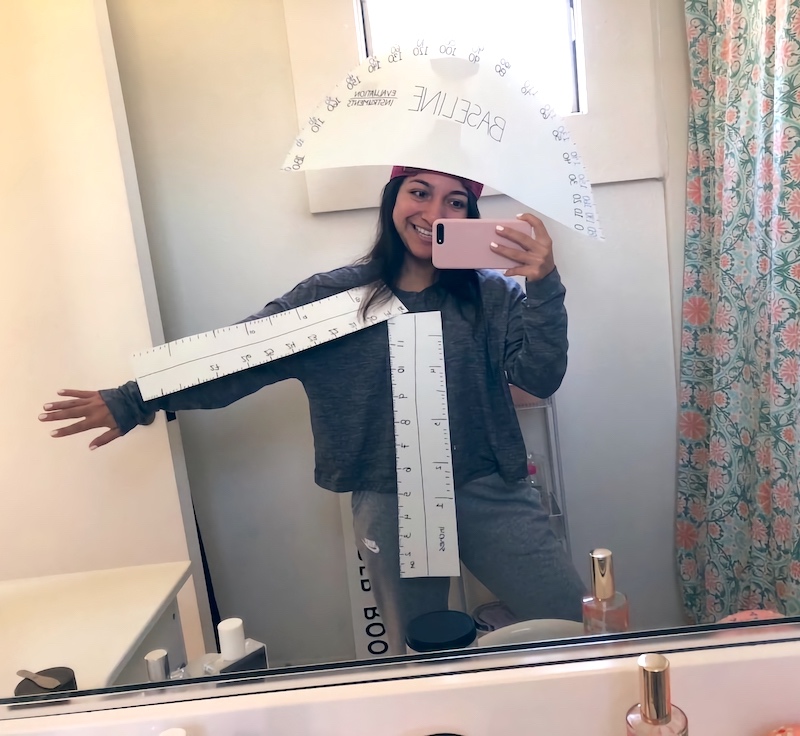
Check out my costume — I am supposed to be a goniometer!
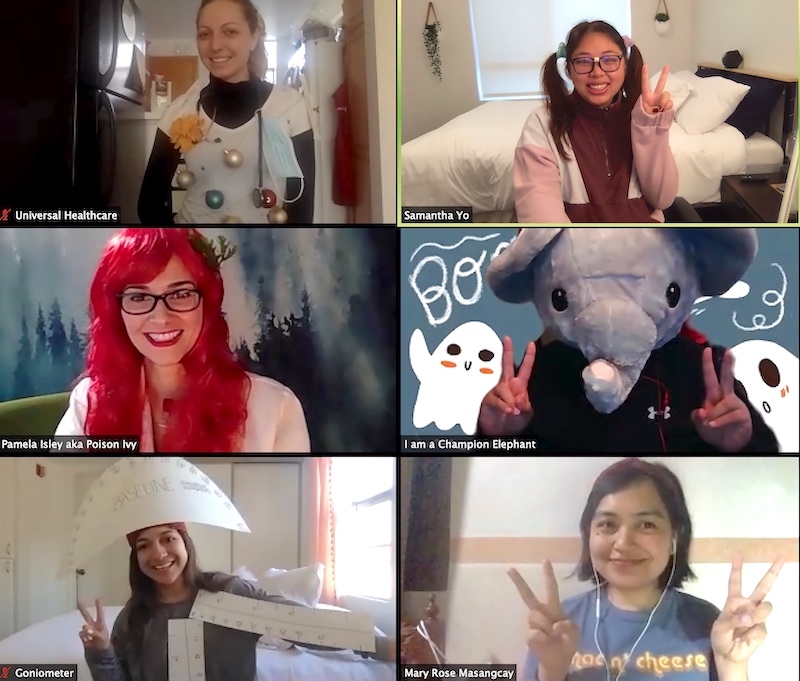
The lovely Trojans I’ve been working with in PAMs all semester showing their Halloween costumes!
If you’re as passionate about hands as I am, you’ll definitely get so much out of these two electives. The content is extremely relevant to hand therapy practice. If you’re interested in becoming certified in PAMs, CBOT requires a minimum of 30 educational hours and 240 supervised hours of PAMs training. The PAMs course counts towards 33 educational hours — so, you would be done with that part! All that’s left to worry about is obtaining the direct training in PAMs, which you could start accumulating hours for when out in practice as a certified OT. Pretty awesome!
⋯





